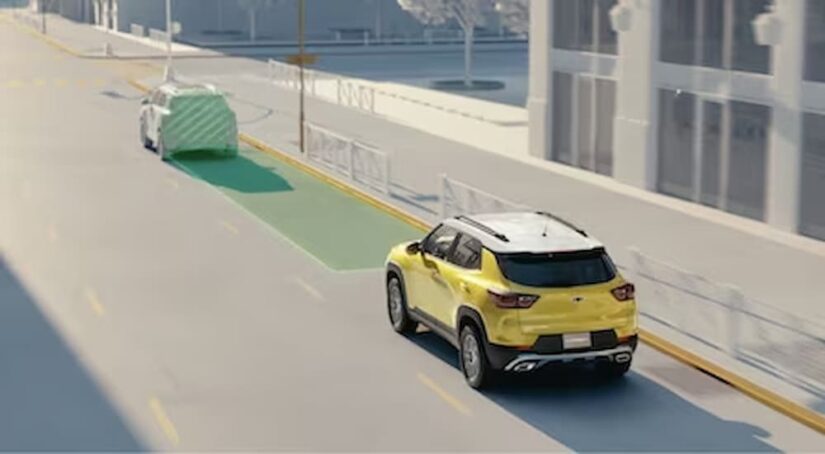Let’s take a trip back in time to the days of baggy jeans, skateboarding, spiked hair, pop punk, and post-grunge. The early 2000s were an adventurous time for many, and I’m not just talking about people––corporations also began taking incredible risks at the turn of the new millennium. The start of the 21st century brought forth an almost tangible level of inspiration and an unshakeable feeling that we were truly in the future. The likes of the Apple iPod and broadband internet were products of this era that helped spark an ever-growing mainstream interest in technology. It was also around this time that automotive manufacturers developed the first driver-assist systems. From this point on, manufacturers knew the future of safety was tied to advanced technology, and today you’ll be hard-pressed to find a new vehicle that doesn’t offer a plethora of advanced driver-assist features.
Chevy is one of the manufacturers leading the safety revolution, and you can find the Chevy Safety Assist suite on all the new models at your nearest Chevy dealer. Many used Chevy cars are also equipped with Chevy Safety Assist, and that’s because the features have been around for a decent while now. Chevy Safety Assist is the brand’s take on advanced driver-assist features developed with innovative technology, and it includes a combination of features that makes it one of the best safety suites yet. But what features will you find in a vehicle with Chevy Safety Assist? That’s what I’m here to discuss, so let’s start with the first item on the list.
Forward Collision Alert
There is a reason I want to cover Forward Collision Alert first: it lays the foundation for a few other features I’ll be discussing. Forward Collision Alert is a warning system that sounds when your Chevy senses an impending collision with a car in front of you. However, it’s worth knowing that Forward Collision Alert will only activate under certain circumstances. The system won’t work at speeds under five mph and may not be too accurate at night or in other situations with low visibility.
Forward Collision Warning is tied to the Following Distance Indicator, which displays the distance between yourself and the vehicle ahead of you in seconds. If the distance closes, you’ll see a visual warning telling you to slow down and create more space between yourself and the other drivers. Aside from a visual warning, you’ll also hear audible beeping tones, and you can choose whether you want these warning tones to begin further away from another vehicle or at the default distance.
Automatic Emergency Braking
I mentioned the Forward Collision Alert leads into a discussion on more safety features, the first of which is Automatic Emergency Braking. Automatic Emergency Braking is the feature that activates when Forward Collision Warning isn’t enough. As a backup measure, Automatic Emergency Braking kicks in if you get dangerously close to the vehicle ahead of you, forcing your Chevy to apply the brakes. The main goal of Automatic Emergency Braking is to prevent a collision between yourself and the car in front of you.
If you were going too fast and it’s physically impossible for you to come to a complete stop in time, Automatic Emergency Braking will lessen the impact and, by extension, the severity of the accident. Automatic Emergency Braking in the Chevy Safety Assist suite is the descendant of the first collision mitigation systems. It is an incredibly valuable feature that can save the life of yourself, your loved ones, and other drivers on the road, and I’m glad it’s part of Chevy Safety Assist.
Front Pedestrian Braking
There’s one caveat to Automatic Emergency Braking: it can only detect other vehicles. Fortunately, that’s where the next feature I want to discuss comes into play. Front Pedestrian Braking is much like Automatic Emergency Braking, but it is designed for urban environments, or anywhere where pedestrians are most likely to cross the roads you’re driving on. Front Pedestrian Braking doesn’t work at higher speeds but can certainly perform within the speed limits found in thickly settled districts. With Front Pedestrian Braking, you can prevent disaster and have a better chance of avoiding the unpredictability that comes from driving, including pedestrians crossing the road when they shouldn’t. It can be hard to predict when someone will step off the sidewalk in front of you, but luckily, features like Front Pedestrian Braking can save lives.
Lane Keep Assist and Lane Departure Warning
The Lane Departure Warning is another alert-style safety feature. As the name implies, it’s designed to keep you safely in your lane. If your vehicle begins drifting into the wrong lane, you’ll hear an audible alert to catch your attention so you can correct your steering. However, should that not be enough, Lane Keep Assist is an assistive steering feature that briefly provides small inputs to the steering wheel to help you correct and keep your vehicle on the road. Don’t think about it like a sharp turn––it’s not like that. Instead, Lane Keep Assist is a subtle feature that won’t jerk your vehicle to the right or left. It’s a smooth process.
High Definition Surround Vision
Having a rearview camera isn’t exciting or innovative anymore. In fact, it is required by law. What is still new to many drivers is having many cameras situated around their vehicles. While it is not technically part of Chevy Safety Assist, many Chevy models have a handful of cameras surrounding the exterior of the car––a feature aptly named High Definition Surround Vision. These cameras are incredibly useful for low-speed maneuvers or to check your surroundings before you put the car into drive. With more cameras comes more viewpoints, meaning you can switch through various camera angles through the infotainment center display.
Additional Driver-Assist Features
Chevy Safety Assist is jam-packed with incredible features that amplify the quality of life of those driving a Chevy vehicle and can prevent disaster on the road. Although about half a dozen features come standard, some additional features are available as options––but that doesn’t mean they’re overly expensive. Features you can add to your Chevy Safety Assist experience include Side Blind Zone and Lane Change Alert, which help you have a better sense of your surroundings so you can be sure it’s safe to switch lanes.
Rear Cross Traffic Alert and Rear Park Assist are two features that make great use of rear-facing radar and sonar to help when backing up. Rear Cross Traffic Alert will notify you if there are vehicles passing behind you when you’re backing out of a parking space or your driveway. Rear Park Assist helps you avoid bumping into any stationary objects when reversing into a parking space.
When taken as a whole, Chevy Safety Assist is a package worth having. Luckily, as I mentioned earlier, if you purchase a new Chevy vehicle, you’re guaranteed to have at least some of these features. I believe Chevy Safety Assist is one of the best safety suites on the market, and it’s only continuing to improve. What will the future bring? That’s a question for another day, but it’s an important one to think about all the same.



